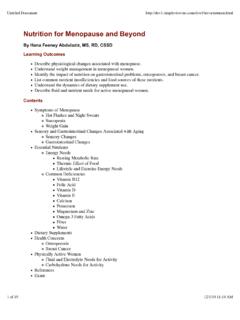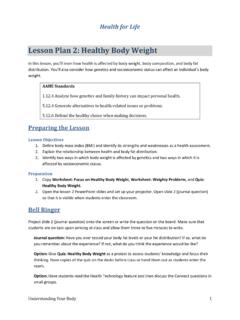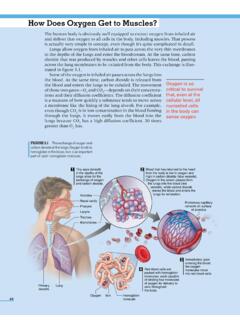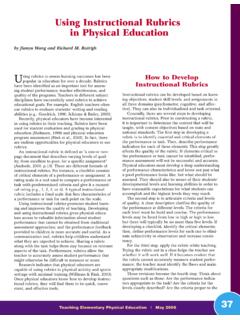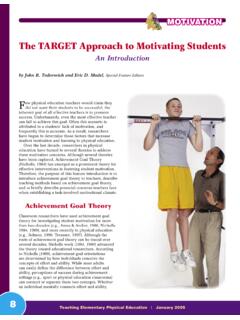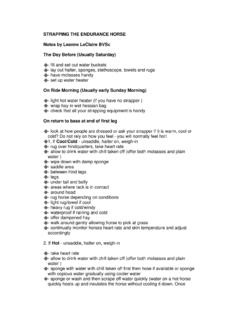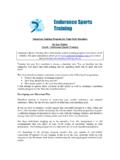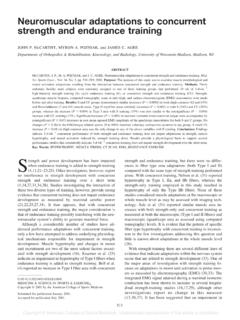Transcription of Cardiorespiratory Endurance - Human Kinetics
1 152 Fitness for Lifewww8 Cardiorespiratory EnduranceIn This ChapterLESSON Endurance FactsSELF-ASSESSMENTStep Test and One-Mile Run TestLESSON Cardiorespiratory EnduranceTAKING CHARGESelf-ConfidenceSELF-MANAGEMENTS kills for Building Self-ConfidenceTAKING ACTIONT arget Heart Rate WorkoutsStudent Web Endurance 153 Lesson Endurance FactsLesson ObjectivesAfter reading this lesson, you should be able to1. describe the health and wellness benefits of Cardiorespiratory Endurance ;2. explain how physical activity benefits the cardiovascular, respiratory, and muscle systems;3.
2 Describe some methods for assessing your Cardiorespiratory Endurance ; and4. determine how much Cardiorespiratory Endurance is Vocabularyaerobic capacity, artery, Cardiorespiratory Endurance , cardiovascular system, cholesterol, fibrin, graded exercise test, high-density lipoprotein (HDL), lipoprotein, low-density lipoprotein (LDL), maximal oxygen uptake, respiratory system, veinwww1Do you have good Cardiorespiratory Endurance ? Do you do enough regular vigorous physical activ-ity to build good Cardiorespiratory Endurance ?
3 Of the 11 parts of fitness, Cardiorespiratory Endurance is the most important because it gives you many health and wellness benefits, including a chance for a longer life. In addition, the activity that you do to improve your Cardiorespiratory Endurance helps you look your best. As shown in figure , Cardiorespiratory Endurance requires fitness of your heart, lungs, blood, blood vessels, and muscles. In this lesson, you ll learn how proper physical activity improves your Cardiorespiratory Endurance .
4 You ll also learn how to assess your Cardiorespiratory Endurance is the ability to exercise your entire body for a long time without stopping. It requires a strong heart, healthy lungs, and clear blood vessels to supply your large muscles with oxygen. Examples of activities that require good Cardiorespiratory Endurance are distance running, swimming, and cross-country skiing. Cardiorespiratory Endurance is sometimes referred to by other names, including cardiovascular fitness, cardiovascular Endurance , and Cardiorespiratory fitness.
5 The term aerobic capacity is also used to describe good Cardiorespiratory function, but it is not exactly the same as Cardiorespiratory Endurance (see this chapter s Science in Action feature).This book uses the term Cardiorespiratory endur-ance. The first word in the term is cardiorespira-tory because two vital systems are involved. Your Arteries(carryingoxygenatedblood)Veins(c arryingdeoxygenatedblood)Muscle cellsLungsHeartE5266/Corbin/Fig. Cardiorespiratory Endurance requires fitness of many parts of the body, including heart, lungs, muscles, and blood system is made up of your heart, blood vessels, and blood.
6 Your respiratory system is made up of your lungs and the air passages that 154 Fitness for Lifebring air, including oxygen, to your lungs from outside of your body. In your lungs, oxygen enters your blood, and carbon dioxide is eliminated. Your cardiovascular and respiratory systems work together to bring your muscle cells and other body cells the materials they need and to rid the cells of waste. Together, the two systems help you function both effectively (with the most benefits possible) and efficiently (with the least effort).
7 The second word in the term Cardiorespiratory Endurance refers to the ability to sustain effort. Together, then, these two words cardiorespira-tory and Endurance refer to the ability to sustain effort, which hinges on fitness of the cardiovascular (cardio) and respiratory of Physical Activity and Cardiorespiratory EnduranceDoing regular physical activity can help you look better by controlling your weight, building your muscles, and helping you develop good posture. Regular physical activity also produces changes in your body s organs, such as making your heart muscle stronger and your blood vessels healthier.
8 These changes improve your Cardiorespiratory Endurance and wellness and reduce your risk of hypokinetic diseases, especially heart disease and activity provides benefits for both your cardiovascular and respiratory systems. In this lesson, you ll learn how each part of these systems benefits and how all the parts work together to promote optimal functioning and good FACTIn the early 1900s, medical doctors referred to an enlarged heart as the ath-lete s heart because athletes hearts tend to be large, and enlarged hearts were associated with disease.
9 By midcentury, research showed that the large heart muscle of a trained athlete was a sign of health, not your heart is a muscle, it benefits from exer-cise and activities, such as jogging, swimming, and long-distance hiking. Your heart acts as a pump to deliver blood to cells throughout your body. When you do vigorous physical activity, your muscle cells need more oxygen and produce more waste prod-ucts. Therefore, your heart must pump more blood to supply the additional oxygen and remove the additional waste.
10 If your heart is unable to pump enough blood, your muscles will be less able to contract and will fatigue more heart s capacity to pump blood is crucial when you re doing physical activity, especially for an extended length of time. Your heart has two ways to get more blood to your muscles by beating faster and by sending more blood with each beat (this is called stroke volume).Your resting heart rate is determined by counting the number of heartbeats per minute when you re relatively inactive. A person who does regular physi-cal activity might have a resting heart rate of 55 to 60 beats per minute, whereas a person who does not exercise regularly might have a resting heart rate of 70 or more beats per minute.


